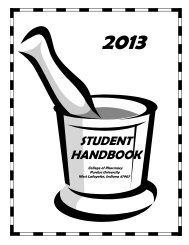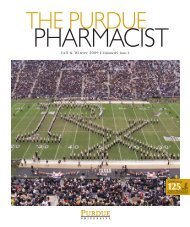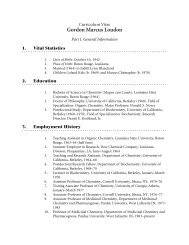Assessment of Instructional Technology - Purdue College of ...
Assessment of Instructional Technology - Purdue College of ...
Assessment of Instructional Technology - Purdue College of ...
Create successful ePaper yourself
Turn your PDF publications into a flip-book with our unique Google optimized e-Paper software.
Final Report <strong>of</strong> the Task Force to Assess <strong>Instructional</strong>/Educational <strong>Technology</strong><br />
(ii) HUBzero technology, Turnitin, Echo 360, Screencorder technology, and the Envision<br />
Center (these are <strong>of</strong> interest to a majority <strong>of</strong> student respondents)<br />
(4) Identify instructional technologies that will facilitate implementation <strong>of</strong> the new PharmD<br />
curriculum.<br />
The new PharmD curriculum will involve dramatic changes to the pedagogical approach <strong>of</strong> the<br />
School. In turn, these changes will trigger a need for new instructional technologies. The School<br />
would benefit by having its IT department consult with course directors and the Curriculum<br />
Committee to identify and address these needs as the new curriculum is developed.<br />
The following examples illustrate how the new curriculum will impact instructional technology<br />
needs in the School:<br />
(i) The new curriculum will place a greater emphasis on in-class discussions and<br />
integration <strong>of</strong> material previously covered by students during independent study rather than<br />
on more conventional didactic lectures. As a result, there will be increased needs for online<br />
assessments (e.g. to ensure that students have mastered relevant background material<br />
before being granted access to the classroom) and for technologies to monitor in-class<br />
participation (e.g. clickers).<br />
(ii) The new curriculum will involve increased mentoring by alumni and practitioners<br />
throughout the state and nation. In addition, Pharmacy Practice faculty from Indianapolis will<br />
be required to carry out their instructional activities at various times throughout the academic<br />
year (to comply with the modular format <strong>of</strong> the new curriculum) rather than during a small<br />
number <strong>of</strong> extended blocks <strong>of</strong> time. Both changes will result in an increased need for highly<br />
optimized video conferencing capabilities.<br />
(5) Pursue various funding mechanisms to support the implementation <strong>of</strong> new instructional<br />
technologies.<br />
Different instructional technologies will require commitments <strong>of</strong> time and funding on different<br />
scales. Some technologies are already in place and require no additional investments. For<br />
example, clicker technology has already been implemented in the School, and the only expense<br />
involved with use <strong>of</strong> clickers is that each student must purchase a unit for $20. In contrast, the<br />
development <strong>of</strong> projects involving the Envision Center is substantially more costly. In cases<br />
such as this it is imperative that resources be identified to assist in development <strong>of</strong> the<br />
educational activity and, most importantly, that we implement some form <strong>of</strong> assessment to<br />
determine if the students truly learn as much or more than they would in the absence <strong>of</strong> the<br />
instructional technology. If the assessment component proves the utility <strong>of</strong> a given technology,<br />
then it may be justified to increase the scope <strong>of</strong> financial investment needed to fully utilize this<br />
type <strong>of</strong> capability.<br />
There are possibilities for grant money that can be used to develop instructional technologies,<br />
and ITaP personnel appear more than willing to work with faculty to discover innovative ways <strong>of</strong><br />
financing the implementation <strong>of</strong> these projects. Faculty members should be encouraged to apply<br />
for Digital Content Development Grants, perhaps with incentives such as matching funds from<br />
the Dean’s <strong>of</strong>fice. (The survey results indicated that although most faculty members had limited<br />
awareness <strong>of</strong> the Digital Content Development Grants, the majority expressed an interest in<br />
participating in this program). It would also be beneficial to seek gift money in support <strong>of</strong> the<br />
School’s efforts to develop new instructional technologies. Finally, revenue may be generated<br />
by marketing online educational content developed using the School’s technologies (e.g.<br />
recorded lectures) to programs at other universities.<br />
Page 4





